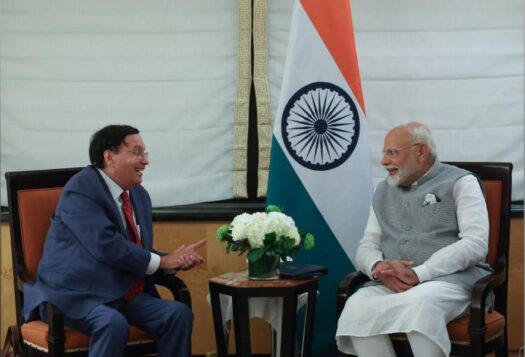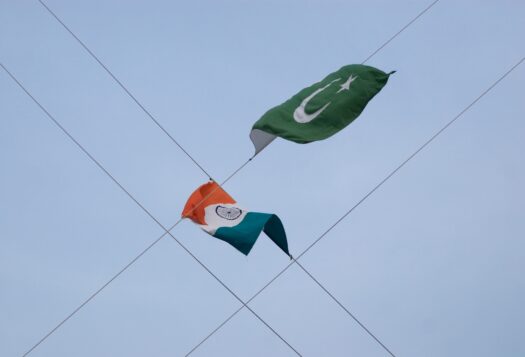
The existing literature on Pakistan’s short-range, nuclear-capable ballistic missile (Hatf-IX) Nasr has so far generated more confusion than clarity about the implications of its role and effectiveness. It is largely anticipated that if India chooses to put its Cold Start Doctrine (CSD) in action, Pakistan will retaliate to any attack staged by Indian conventional forces with the Nasr missile. This has produced a stream of criticism from Indian and Western quarters, who have rushed to label Nasr’s development as a means of lowering the nuclear threshold and increase the risk of inadvertent escalation. Thus, while Pakistan argues that Nasr is a crisis-manager specifically developed to deter any conventional attack by denying space for limited conventional operations, the missile has been viewed as a crisis-enhancer by its critics. Adding to this debate, Survival published a paper by Ben Barry, senior fellow for land warfare at the International Institute of Strategic Studies, titled, “Pakistan’s Tactical Nuclear Weapons: Practical Drawbacks and Opportunity Costs.” This academic piece raises controversial yet debatable criticisms regarding Pakistan’s Nasr system.
Summary
Barry maintains that Pakistan’s likely response to any conventional aggression by India would be an early deployment of tactical nuclear weapons (TNWs) that could communicate a “credible threat of limited nuclear use on Indian forces invading Pakistan.” Whereas, he adds, Cold Start is likely to be an “option of last resort” in presence of a range of other options that India possesses against Pakistan, i.e. surgical strikes. Barry’s article supports the prevalent manifestation that Pakistan’s strategy is based on its TNWs, particularly Nasr, to discount India’s conventional superiority, as part of Pakistan’s full-spectrum nuclear deterrence posture.
While Pakistan argues that Nasr is a crisis-manager specifically developed to deter any conventional attack by denying space for limited conventional operations, the missile has been viewed as a crisis-enhancer by its critics.
In this context, the author questions the “utility or value for money” of Nasr in achieving Pakistan’s objectives. While discussing the deployment of TNWs in a conventional conflict, Barry addresses the operational complexities (i.e. the existence of a protective command and control apparatus) of Nasr in the battlefield based on the perceived policy to use Nasr—a nuclear weapon—as a “conventional-maneuver” weapon. He also expresses apprehensions on Pakistan’s options in the event India launches a nuclear counterforce strike in response to Pakistan’s use of TNWs. Attributing little practical utility of TNWs against conventional aggression, Barry focuses on the opportunity costs posed by TNWs. He argues that funds spent on TNWs are not available to be spent on conventional capabilities, though prioritizing conventional capabilities over TNWs would have better improved the existing conventional asymmetry vis-a-vis India.
Nasr as a Weapon of Last Resort
Barry believes that India’s Cold Start will be an option of last resort, but overlooks that Pakistan’s Nasr missile is also a weapon of last resort. By and large, Pakistan’s “low-yield nuclear weapons response” to any possible India’s conventional invasion dominates the narrative, as witnessed in Barry’s piece. This logic runs contrary to statements by Pakistani officials, which have reiterated Pakistan will only use nuclear weapons as last resort. In fact, Pakistan has five defensive corps located in Gujranwala, Lahore, Karachi, Bahawalpur, and Rawalpindi. These defensive corps are Pakistan’s first line of defense against any conventional attack from India—with two additional defensive corps in Quetta and Peshawar, which can also be deployed to reinforce the other formations facing India. Accordingly, the use of Nasr—or any other nuclear capable missile systems—will occur in the case of deterrence failure to prevent the loss of Pakistani territory or the impending defeat of Pakistan’s conventional forces.
Moreover, Barry also over-exaggerates the centrality of Nasr in Pakistan’s nuclear retaliation against an Indian conventional attack. Any decision to employ nuclear weapons made by the Pakistani National Command Authority (NCA) will not be limited to the use of short-range systems like Nasr. Once Pakistan’s nuclear thresholds are breached, its response is likely to involve both countervalue and counterforce targeting.

Nasr as a Weapon of Deterrence
The genesis of Nasr lies in its strategic significance to act as a weapon to deter the enemy from any military attack that could escalate into full-scale war.
Barry does not consider that the Nasr missile bolsters Pakistan’s full-spectrum deterrence in a way that cannot be achieved with conventional weapons. However, the genesis of Nasr lies in its strategic significance to act as a weapon to deter the enemy from any military attack that could escalate into full-scale war. Pakistan’s purpose in lowering the nuclear threshold by stating that it will deploy Nasr in response to a sudden conventional incursion by India is designed first for deterrence—to deny India the space to wage an attack against Pakistan. Additionally, the Nasr system is also designed to add value to Pakistan’s conventional deterrent capabilities. Lieutenant General (ret.) Khalid Kidwai at the 2015 Carnegie International Nuclear Policy Conference emphasized the ability of Pakistan’s nuclear weapons to “reinforce…[the] deterrence value of conventional forces,” with the Nasr missile’s induction in particular making “India think twice, if not ten times” about initiating CSD.
Pakistan’s intention to use the Nasr missile as a weapon of deterrence and not a weapon of war-fighting is highlighted by the fact that Pakistan’s short range nuclear weapons are not positioned under delegative control of the army corps. Thus, they will not be employed in the battlefield under the Army Strategic Force Command managed by the NCA, but will remain centralized until selected for use.
Conventional Measures to Counter Cold Start
Barry’s critique of Pakistan’s TNWs centers on his claim that the money Pakistan spends on TNWs may not be cost effective, since “all the necessarily resource-intensive security, support, and command and control is money that cannot be spent on modern conventional capabilities.” This argument presents Pakistan’s response to India’s CSD to be limited to the development of TNWs. However, alongside the development of TNWs, Pakistan has been undertaking parallel efforts in the conventional domain to build a range of other options. In fact, Pakistan is modernizing and upgrading its conventional capabilities through defense partnerships to validate its operational preparedness and develop a comprehensive response to counter Indian proactive war strategies.
Pakistan is modernizing and upgrading its conventional capabilities through defense partnerships to validate its operational preparedness and develop a comprehensive response to counter Indian proactive war strategies.
A gradual but visible rise in Pakistan’s military expenditure can be noticed lately with an increase in defense spending (i.e. operating, defense procurement, and military modernization) that will improve its fleet size and conventional capability. Furthermore, reports emerged in 2017 and 2018 that Pakistan may be acquiring or upgrading conventional weapons systems, including main battle tanks (i.e. third-generation VT4 from China and T-90 from Russia), air-defense systems (such as the Chinese LY-80), attack helicopters (i.e. the Mi-35M from Russia), aircrafts (i.e. the induction of Chinese and Swedish Saab 2000-based Erieye airborne AEW&C aircraft), and warships (i.e. Type 054A Jiangkai II frigate from China).
To assess and improve the efficacy of Pakistan’s conventional response to any hostile doctrine such as CSD, Pakistan conducted four conventional military exercises near Pakistan’s eastern border with the codename Azm-e-Nau or “New Resolve” from 2009 to 2013. After Azm-e-Nau, Pakistan’s “new concept of warfighting” (NCWF) was devised to improve the synergy of the three services and the quick mobilization of troops and other military assets. Furthermore, the comprehensive exercise “High Mark” is held every five years by the Pakistan Air Force to improve a synchronized response with the Army along the Eastern Front. Other military drills, such as Strike of Thunder, Raad ul Barq, and Sea Spark have continued in recent times. These drills, as well as Pakistan’s recent focus on conventional defense acquisitions, are evidence that Pakistan has not relied singularly on TNW’s to deter India and counter CSD, but have aimed to use TNWs to complement growing conventional capabilities to the same end.
Conclusion
Barry’s primary argument that “funds spent on tactical nuclear weapons have not been available to spend on conventional capabilities” discounts the value TNW’s add to Pakistan’s credible full-spectrum deterrence and overlooks Pakistan’s increased spending on military assets overall, including on conventional capabilities. Without taking into account these important considerations, Barry’s article perpetuates to the uneven yet prevalent narrative on CSD and Nasr. In reality, the counterforce debate in South Asia remains overly focused on Pakistan, while India’s move to conventional and nuclear counterforce capabilities is largely disregarded.
The counterforce debate in South Asia remains overly focused on Pakistan, while India’s move to conventional and nuclear counterforce capabilities is largely disregarded.
A balanced debate is needed regarding India’s own pursuit of short-range ballistic missiles for battlefield use and the likelihood it may launch a swift military campaign via CSD when it has the confidence and capability to do so (i.e. through nuclear counterforce). Pakistan’s development of Nasr forced India to reveal its battlefield missile capabilities at that time, and currently India is working on Pinaka MK-II guided rocket launcher (with a range of 60 km), which government sources have indicated has the potential to become a tactical asset along with Prahaar (with a range of up to 150 km). India’s ability to launch any kind of limited conventional offensive—for instance, in a scenario that India believes Pakistan will not be able to deter or defeat it using its relatively weak conventional forces or without risking massive retaliation with India’s long-range strategic weapons—is a recipe for deterrence failure, as it could lead to an all-out conventional war with the risk of nuclear escalation.
Editor’s Note: In an ongoing series aimed at bridging the divide between policy analysis and academic scholarship, SAV contributors review recent articles and books published by leading scholars to evaluate the latest theoretical and analytical debates on strategic issues and their implications for South Asia. Read the series here.
***
Click here to read this article in Urdu.
Image 1: Shahzeb Younas via Flickr
Image 2: Aamir Qureshi via Getty Images


